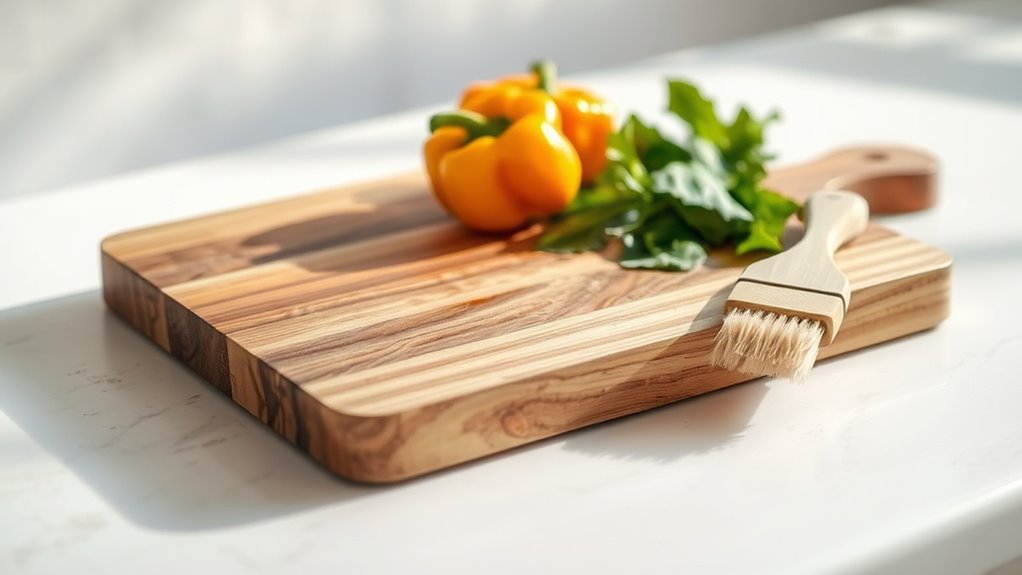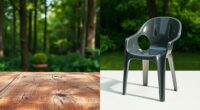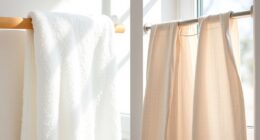To avoid cross-contamination with wooden cutting boards, use separate boards for raw meats, vegetables, and cooked foods, preferably color-coded for easy identification. Always wash your boards thoroughly with hot, soapy water, and sanitize them with a bleach solution or food-safe disinfectant after each use. Inspect your boards regularly for deep cracks or damage and replace them when necessary. Proper storage and diligent cleaning can keep your kitchen safe—more tips are just a step away.
Key Takeaways
- Use separate, color-coded cutting boards for raw meats, produce, and cooked foods to prevent cross-contact.
- Sanitize boards thoroughly with hot, soapy water followed by a bleach solution after each use.
- Avoid placing cooked or ready-to-eat foods on the same surface used for raw meats without cleaning.
- Regularly inspect and replace wooden boards with deep cracks or grooves that can harbor bacteria.
- Store boards in a dry, well-ventilated area to prevent mold, warping, and bacterial growth.
Choosing the Right Wooden Cutting Board for Food Safety
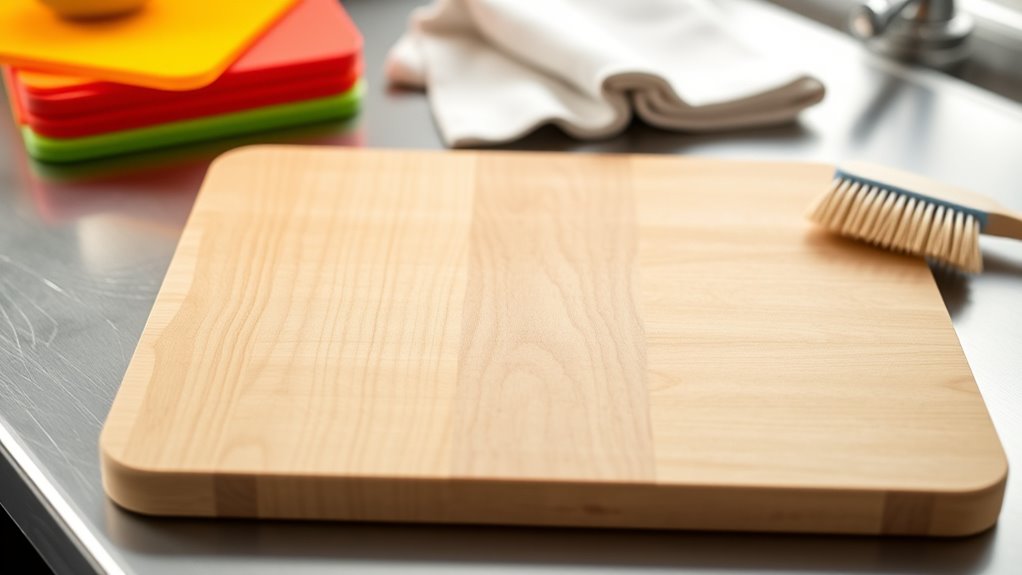
Choosing the right wooden cutting board is essential for maintaining food safety. You want a board labeled as food-grade, which guarantees it’s safe for food contact and free of harmful chemicals. Opt for hardwoods like maple or cherry because they are less porous than softwoods. These dense, durable woods resist bacteria buildup and are less likely to develop cracks or grooves that can trap bacteria. Avoid old or damaged boards with deep cracks, splinters, or grooves, as these can harbor harmful germs. A smooth, dense surface helps prevent bacteria from hiding, making cleaning easier and more effective. Look for a flat, stable base with non-slip features to reduce movement during use. Regularly inspect your board and replace it if you notice cracks or other damage to keep your food safe.
Proper Techniques for Washing and Sanitizing Wooden Boards
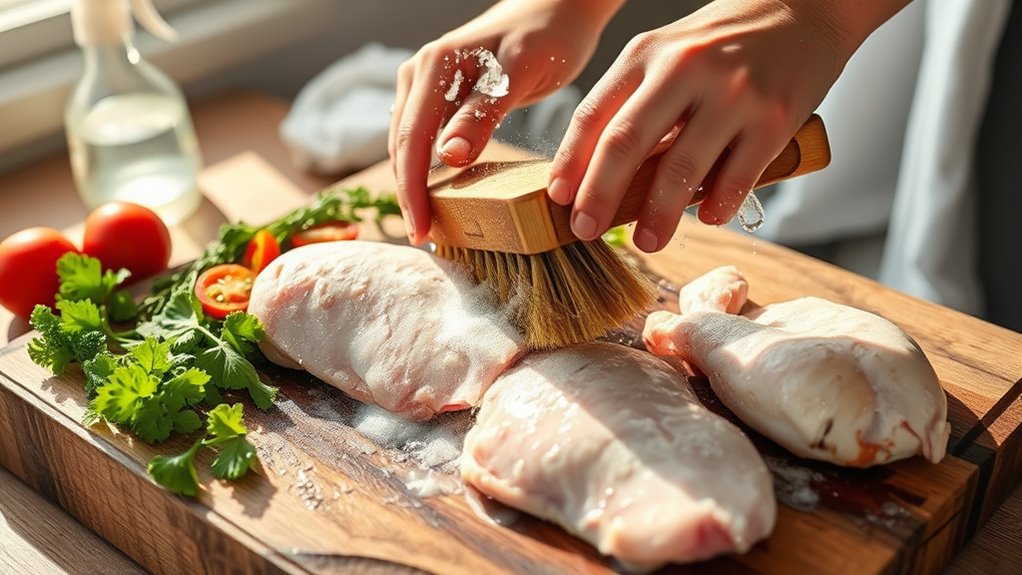
To keep your wooden cutting board safe from bacteria, it’s important to wash it properly after each use. Start by cleaning the surface with hot, soapy water to remove food residues and bacteria effectively. Rinse thoroughly with clean water to eliminate soap and prevent residues that could harbor bacteria. For sanitizing, use a solution of one tablespoon of unscented chlorine bleach per gallon of water, ensuring the surface stays wet for a few minutes before rinsing. Avoid placing wooden boards in dishwashers because high heat and moisture can cause warping and reduce their sanitation. After cleaning and sanitizing, let the board air dry completely or dry with a clean towel. Proper washing and sanitizing are essential to prevent cross-contamination and maintain a safe food preparation surface. Additionally, understanding proper voiceover techniques can help you communicate safety tips more effectively when educating others. Regular inspection and maintenance of your wooden boards also play a vital role in food safety practices, and being aware of damage and wear can help prevent bacterial buildup and ensure longevity. Incorporating AI-driven innovations in sanitation methods may further enhance the effectiveness of your cleaning routines. Moreover, staying informed about pinball machine safety can help prevent accidents when setting up or moving heavy equipment.
Using Separate Boards for Raw Meats and Ready-to-Eat Foods
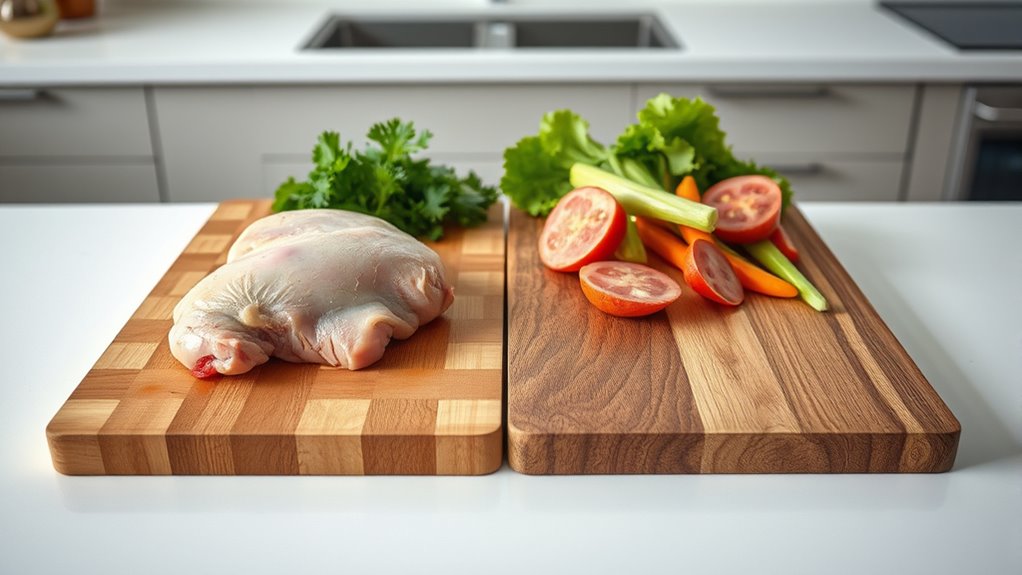
Using separate cutting boards for raw meats and ready-to-eat foods is essential to prevent cross-contact. Color-coded boards make it easy to distinguish between them and reduce the risk of bacteria transfer. Always switch and clean boards thoroughly if you switch from raw meat to other foods.
Prevent Cross-Contact
Preventing cross-contact begins with assigning separate cutting boards for raw meats and ready-to-eat foods. Using different boards for raw meat helps prevent cross-contamination, which can transfer bacteria to cooked or prepared foods. Always wash and sanitize each board thoroughly after handling raw meat before switching to other foods. This step ensures that any bacteria from raw meat are eliminated, reducing the risk of cross-contact. Never place cooked or ready-to-eat items on the same surface used for raw meat without cleaning it first. Regularly inspect your boards for cracks or grooves where bacteria can hide, and replace them if needed. Proper cleaning and designated boards are essential to keep your food safe and prevent the spread of harmful bacteria.
Use Color-Coded Boards
Implementing a color-coded system for your cutting boards can substantially reduce the risk of cross-contamination. Assign specific colors to different foods to visually distinguish their use. For example, use red for raw meats, green for vegetables, and yellow for cooked foods. Keep these boards consistent and clearly labeled to prevent accidental cross-contact. Regularly inspect and replace worn or deeply scored boards to maintain hygiene and food safety. Here’s a simple visual:
| Red | Green | Yellow |
|---|---|---|
| Raw meats | Vegetables | Cooked foods |
| Raw poultry | Fresh produce | Ready-to-eat |
Using such color-coding helps you quickly identify the right board, reduce bacteria transfer, and ensure food safety in your kitchen. Additionally, understanding food safety principles is essential to prevent illness and ensure proper handling of raw foods. Incorporating proper sanitation practices between uses further enhances safety and reduces contamination risks. Maintaining proper hygiene standards is crucial for effective infection control in food preparation areas.
Recognizing Signs of Wear and When to Replace Your Wooden Board

It’s important to regularly inspect your wooden cutting board for signs of wear that could pose health risks. Look for cracks, gouges, or deep grooves, as these can harbor bacteria and indicate the need for replacement. Notice if your board develops persistent odors or stains despite cleaning — these suggest bacterial buildup. Discoloration that can’t be scrubbed away, especially if it’s accompanied by mold, is a clear sign to discard it. Additionally, excessive warping or splintering compromises the board’s surface, increasing contamination risks. Being aware of best practices for board maintenance can help extend its usability and ensure food safety. Regular sanitation protocols can prevent the buildup of harmful microbes that contribute to cross-contamination on wooden surfaces. Incorporating proper cleaning techniques can further reduce microbial presence and promote safety. Understanding bioluminescent fungi can also remind us of the importance of proper sanitation to prevent unseen microbial growth.
Effective Disinfection Methods for Wooden Surfaces
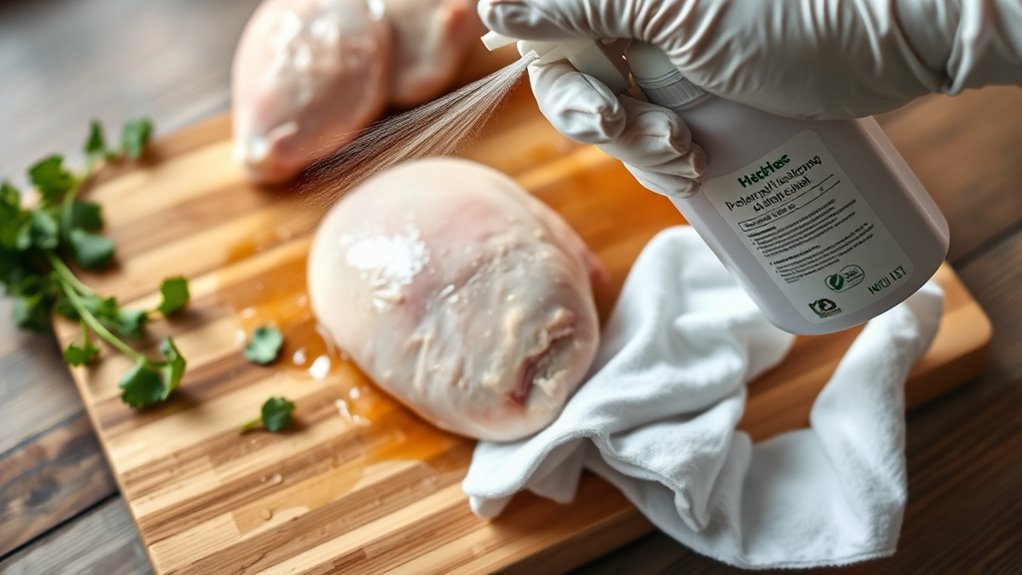
To effectively disinfect wooden cutting boards, start by cleaning the surface with hot, soapy water to remove food residues and dirt. This initial step helps eliminate surface bacteria and prepares the wood for sanitizing. For disinfecting, mix one tablespoon of unscented chlorine bleach per gallon of water and apply it to the surface, ensuring it stays wet for a few minutes. Rinse thoroughly afterward to remove any chemical residues. Since wood is porous, hand sanitization with FDA-approved disinfectants is recommended over dishwashers, which can cause warping or cracking. Dry the surface completely with paper towels or a clean cloth to prevent moisture buildup that promotes bacterial growth. Regular disinfection reduces the risk of cross-contamination and keeps your wooden surface safe for food prep. Additionally, understanding AI and automation can help improve food safety protocols by optimizing cleaning schedules and monitoring sanitation processes, especially when dealing with porous materials that require careful maintenance. Incorporating automated monitoring systems can further enhance sanitation by providing real-time alerts and ensuring consistent cleaning standards, leveraging advanced sensors to detect contamination levels more accurately. Proper maintenance and use of disinfection tools contribute to the longevity and safety of your wooden surfaces.
Maintaining Your Wooden Cutting Board With Proper Storage and Care

After disinfecting your wooden cutting board, proper storage and care help maintain its cleanliness and longevity. To keep your board safe and in top shape, follow these steps:
- Store your board in a dry, well-ventilated area to prevent moisture buildup that can lead to bacteria and mold.
- Keep boards upright or hung to ensure proper air circulation, reducing the risk of mold.
- Avoid stacking wet or improperly dried boards, as trapped moisture fosters bacteria and mold growth.
- Regularly inspect your board for deep cracks, gouges, or warping, and replace it if necessary. Proper cleaning and dry storage are essential to prevent cross-contamination and extend your wooden cutting board’s lifespan.
- Using proper storage techniques can further enhance the longevity and safety of your wooden cutting board by preventing damage and contamination. Incorporating space optimization strategies can help you organize your kitchen tools more effectively and maintain a clutter-free environment.
Avoiding Cross-Contact During Food Preparation Processes
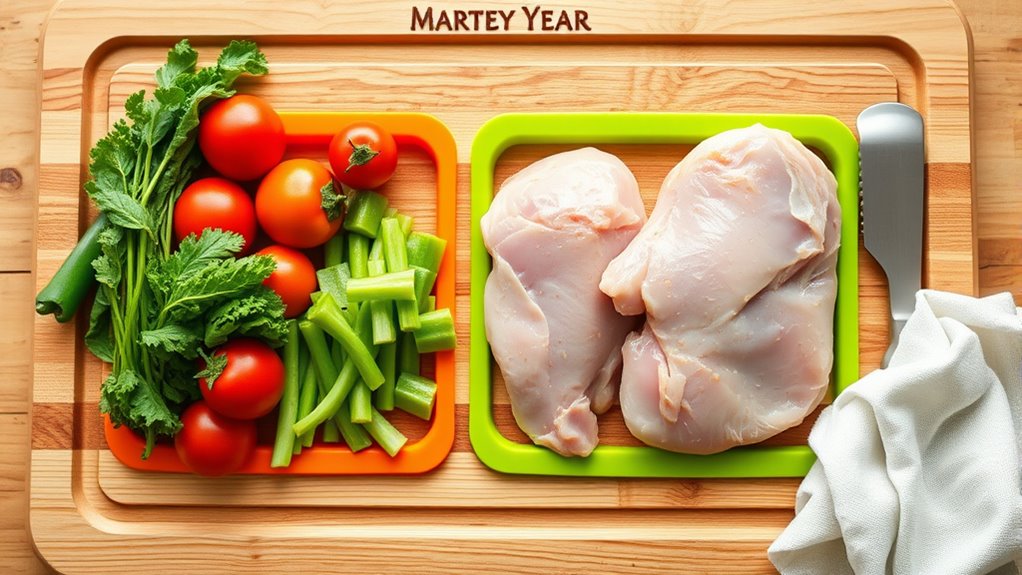
Preventing cross-contact during food preparation is essential to guarantee food safety. Always use separate cutting boards for raw meats and ready-to-eat foods to avoid cross-contamination. After handling raw meat, thoroughly clean and sanitize your cutting board with hot, soapy water and a disinfectant before working on other ingredients. Use clean utensils and knives for different food items, especially when changing from raw meat to produce or cooked foods. Proper storage also helps prevent cross-contact; keep raw meat on the bottom shelf or in sealed containers away from other foods. Regularly inspect your wooden cutting boards for deep cracks or grooves, which can harbor bacteria. Replacing damaged boards reduces the risk of bacteria transfer and helps maintain a safe food contact environment. Additionally, implementing quality assurance practices such as routine inspections can help identify potential contamination risks early on. Staying informed about food safety practices can further minimize risks, much like staying updated on crypto market trends and insights to make smarter investment decisions. Regularly rotating your cutting boards and dedicated use for specific food groups can also help prevent bacterial buildup and cross-contact. It is also advisable to consider the material of your cutting boards, as some materials are more resistant to bacteria and easier to clean than others.
The Importance of Hand Hygiene and Kitchen Cleanliness
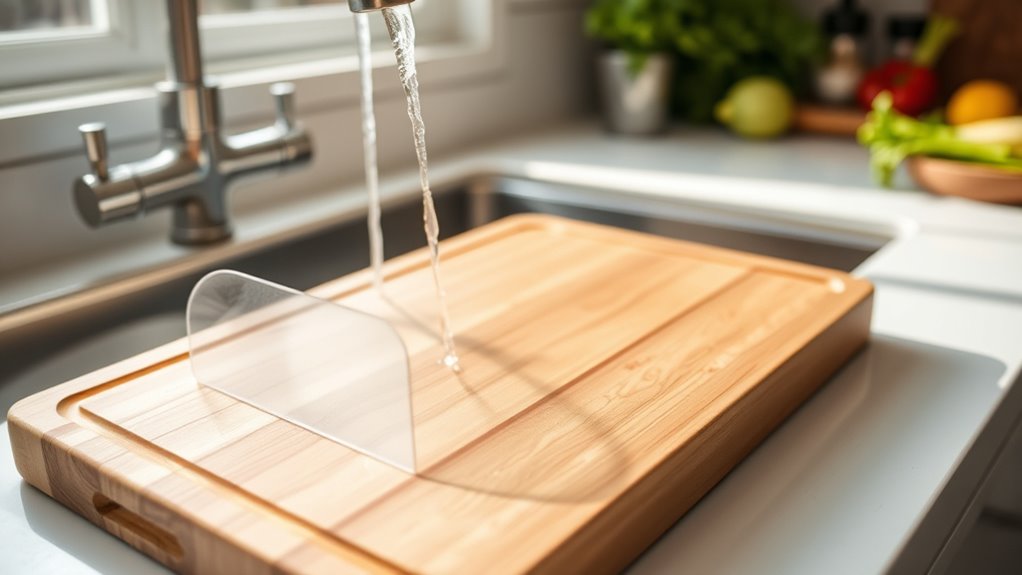
Proper hand hygiene and maintaining a clean kitchen environment are key steps in preventing cross-contamination during food preparation. When you wash your hands with soap and hot water before and during cooking, you greatly reduce bacteria transfer. Rewashing after bathroom breaks, pet contact, or handling raw meat keeps germs from spreading to tools and ingredients. To guarantee kitchen cleanliness, regularly sanitize countertops with vinegar or hydrogen peroxide, creating a safe zone for food prep. Remember:
- Wash hands thoroughly and often to stop bacteria in their tracks.
- Rewash after any contact with animals, raw meat, or bathroom use.
- Keep surfaces sanitized to prevent bacterial buildup.
- Recognizing angel number soulmate patterns can help you become more aware of love opportunities in your life.
Tips for Restoring and Resurfacing Worn Wooden Boards
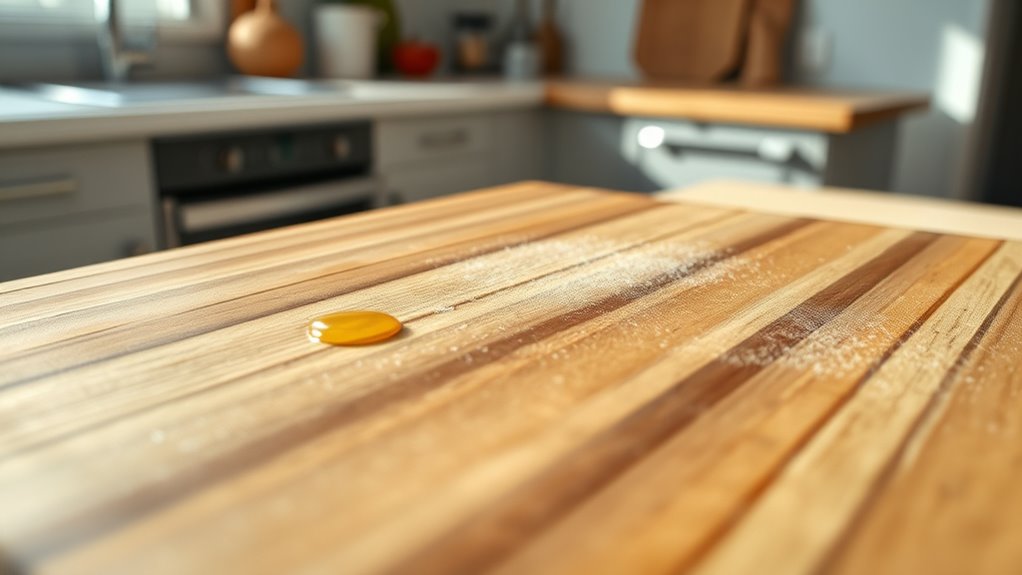
When your wooden cutting board shows signs of wear, restoring its surface is essential for food safety and longevity. To resurface it, start by sanding with fine-grit sandpaper to gently remove surface scratches and deep grooves. This process helps create a smooth, less bacteria-harboring surface. After sanding, thoroughly clean the board with hot, soapy water and rinse to eliminate wood dust and debris. Once dry, apply a food-grade mineral oil or beeswax finish to condition the wood and help seal against moisture and bacteria infiltration. Regularly inspect your resurfaced board for new cracks or gouges, sanding again as needed. Avoid harsh chemicals or bleach during this process—stick to gentle sanding and natural oils to preserve the wood’s integrity and safety.
Additional Strategies to Minimize Bacterial Transfer in the Kitchen
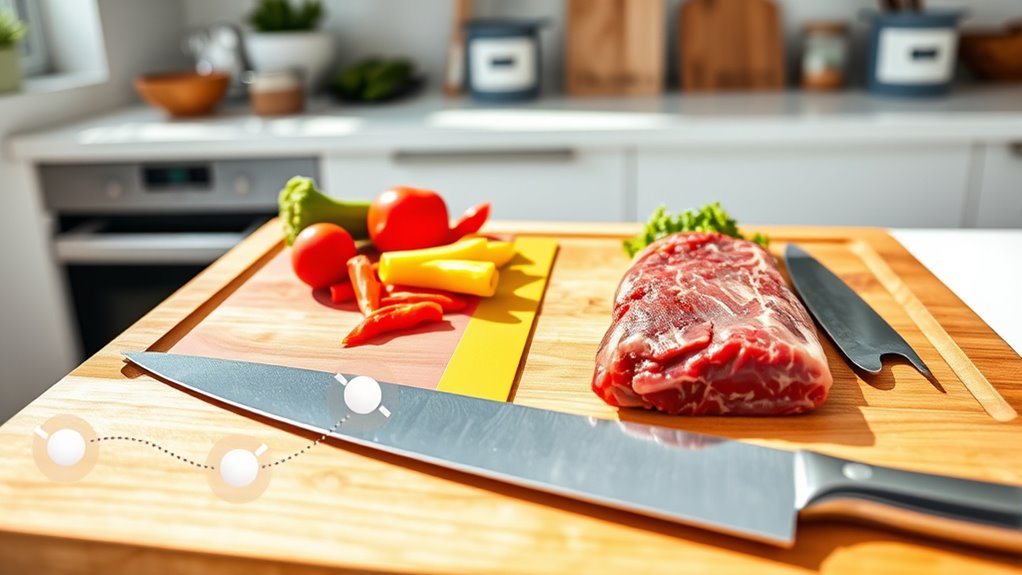
Using separate boards for raw meats and produce helps prevent cross-contact. Regularly sanitize your boards with a proper cleaning solution and store them in a dry, safe place. These steps are essential to keep bacteria off your knives and prevent contamination.
Use Separate Boards
To effectively prevent cross-contamination, it is essential to designate specific cutting boards for different types of foods. Using separate boards minimizes bacteria transfer and enhances food safety. Consider these steps:
- Assign one board solely for raw meats, ensuring bacteria stay contained.
- Use another board for fruits and vegetables, preventing raw meat bacteria from contaminating produce.
- Apply color-coded boards to instantly distinguish between food types, reducing mistakes.
Storing raw meat and produce separately in the fridge also supports this separation. Regularly clean and disinfect each board before switching tasks to maintain hygiene. Avoid using boards with deep cracks or grooves, as bacteria hide there, increasing contamination risks. By using separate boards, you create a safer kitchen environment and protect yourself and your loved ones from foodborne illnesses.
Sanitize Regularly and Properly
Regularly sanitizing your wooden cutting boards is essential for preventing bacterial buildup and ensuring food safety. To sanitize, use a solution of one tablespoon of unscented chlorine bleach per gallon of water, making sure the surface stays wet for at least one minute. Avoid soaking your wooden boards in water for long periods, as excess moisture can cause warping and promote bacteria growth. Instead, opt for quick disinfecting rinses, then air dry or pat dry thoroughly to prevent mold and bacteria proliferation. Regularly inspect your boards for deep cracks or grooves; replace damaged ones or sand and re-oil to keep the surface smooth and hygienic. Proper sanitization helps prevent cross-contamination, keeping your kitchen safer and your food prepared more hygienically.
Store Properly and Safely
Proper storage plays a key role in maintaining the hygiene of your wooden cutting boards. To keep them safe, focus on three key steps:
- Store your boards in a dry, well-ventilated area to prevent moisture buildup, which encourages bacterial growth.
- Keep boards separated by type—raw meat, produce, or cooked foods—to avoid cross-contamination. Use designated, clearly labeled compartments or racks.
- Avoid stacking multiple boards directly; instead, store them upright or flat with space for airflow and drying.
Always verify your boards are completely dry before storage to prevent mold and bacteria. Regularly inspect for cracks or damage, and replace damaged boards promptly. Proper storage is essential to keep your kitchen safe.
Frequently Asked Questions
How to Prevent Cross Contamination on Cutting Board?
You want to prevent cross-contamination on your cutting board. Start by using separate boards for raw meats and ready-to-eat foods. After each use, wash with hot, soapy water and sanitize with a bleach solution. Regularly inspect your boards for deep cracks or grooves and replace them if needed. Clean engraved or textured areas thoroughly with a toothbrush, and store your boards in a dry, clean place to keep bacteria at bay.
How Do You Make a Wooden Cutting Board Food Safe?
To make your wooden cutting board food safe, start by thoroughly washing it with hot, soapy water and rinsing well. Sanitize with a solution of one tablespoon of unscented bleach in a gallon of water, then rinse and air dry. Regularly refinish and seal the surface with food-grade mineral oil or beeswax to prevent cracks and bacterial buildup. Replace the board if it develops deep cracks or warping.
How Can I Sanitize a Wooden Cutting Board?
You’re about to turn your wooden cutting board into a bacterial fortress! To sanitize, mix one tablespoon of unscented bleach in a gallon of water. Fully cover the surface with this solution, then let it sit for at least a minute. Rinse thoroughly, dry completely, and avoid the dishwasher. This simple routine keeps your board safe, clean, and bacteria-free, ensuring every cut is as safe as possible.
Is a Wooden Cutting Board Sanitary?
A wooden cutting board can be sanitary if you take proper care of it. You should regularly scrub it with hot, soapy water and guarantee it’s thoroughly dried. Avoid boards with deep cracks or grooves, as they can harbor bacteria. Applying food-safe mineral oil helps keep the surface sealed. After handling raw meat, disinfect with an FDA-approved solution. By maintaining your board properly, you keep it safe for food prep.
Conclusion
By choosing the right board and maintaining strict hygiene, you protect your kitchen from cross-contamination. Yet, even the best practices can’t erase wear and bacteria entirely—your wooden board’s surface tells a story of countless meals prepared. Staying vigilant, replacing worn boards, and practicing good hand hygiene create a balance between tradition and safety. In the end, your mindful approach transforms a simple tool into a safeguard, ensuring your kitchen remains both warm and hygienic.
